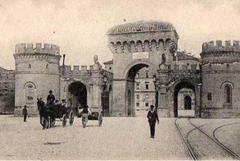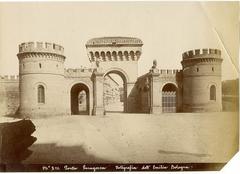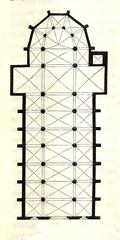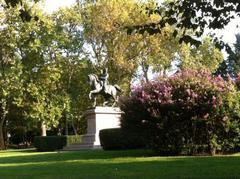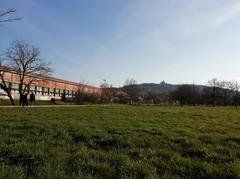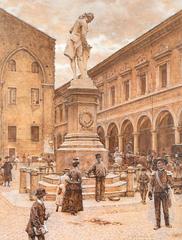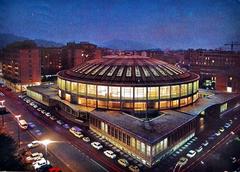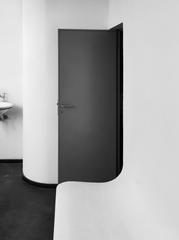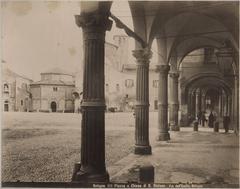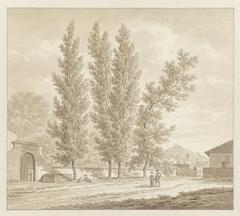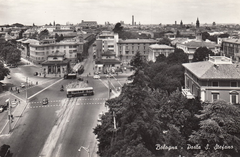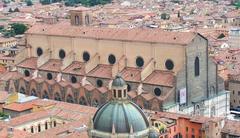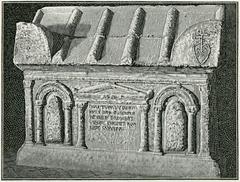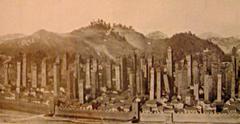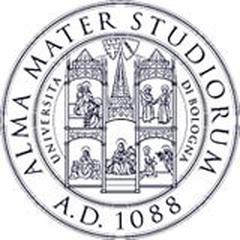
Porta Saragozza Visiting Hours, Tickets, and Historical Significance
Date: 18/07/2024
Introduction
Table of Contents
- Introduction
- Historical Background and Significance
- Visitor Information
- Key Attractions and Points of Interest
- Getting There and Around
- What to See and Do
- Nearby Attractions and Special Events
- Where to Eat and Drink
- Where to Stay
- Practical Tips
- Conclusion
- FAQ
Historical Background and Significance
Roman Origins and Medieval Transformations
The gate’s origins can be traced back to the Roman era, specifically to the 1st century BC, when it was known as Porta Nova. This original gate served as a crucial entry point to the Roman city of Bononia, the predecessor to modern-day Bologna.
During the medieval period, Bologna experienced significant growth and expansion. Around the 10th century, the city’s defensive walls were extended, and Porta Nova underwent a series of transformations. It was during this time that the gate acquired its current name, Porta San Mamolo, named after a nearby church dedicated to Saint Mammas.
The Arrival of the Bentivoglio Family and Architectural Splendor
The 15th century marked a turning point in the gate’s history with the rise of the powerful Bentivoglio family, who ruled Bologna as signori (lords). Under their patronage, the city flourished, and Porta San Mamolo underwent a significant reconstruction.
In 1425, Antonio di Vincenzo, a renowned architect of the time, was commissioned to redesign the gate. He transformed it into a formidable defensive structure, characterized by its imposing tower and fortified walls. This reconstruction aimed to enhance the city’s defenses against potential invaders and solidify the Bentivoglio family’s control over Bologna.
The Renaissance Influence and Symbolic Significance
The Renaissance, which swept across Italy in the 15th and 16th centuries, left its mark on Porta San Mamolo as well. During this period, the gate was adorned with decorative elements, reflecting the artistic sensibilities of the time.
One notable addition was the placement of terracotta statues depicting Saint Petronius, the patron saint of Bologna, and Saint Proculus, another important local saint. These statues, crafted by the renowned sculptor Niccolò dell’Arca, served not only as religious symbols but also as a testament to the city’s piety and artistic heritage.
From Defensive Structure to Symbolic Gateway
With the passage of time and the evolution of warfare, Porta San Mamolo’s role as a defensive structure gradually diminished. However, its symbolic significance as a gateway to the city remained intact.
In the 17th century, the gate underwent further renovations, transforming it into a more welcoming entrance to Bologna. The drawbridge, once a crucial defensive feature, was replaced with a permanent bridge, and the surrounding area was redesigned to create a more aesthetically pleasing approach to the city.
Porta Saragozza - A Name Change and Enduring Legacy
The name Porta Saragozza, by which the gate is commonly known today, came into use in the 19th century. This name change reflected the gate’s location on the road leading to Zaragoza, Spain.
Today, Porta Saragozza stands as a proud reminder of Bologna’s rich history and architectural heritage. It serves as a tangible link to the city’s Etruscan, Roman, medieval, and Renaissance past, showcasing the evolution of its architectural styles and the influence of powerful families like the Bentivoglios.
Visitor Information
Visiting Hours
Porta Saragozza is accessible to visitors year-round. However, it is recommended to check the local tourism website for any changes to visiting hours or special closures.
Ticket Prices
There is no entrance fee to visit Porta Saragozza, making it an easily accessible site for all tourists and locals alike.
Travel Tips
- How to Get There: Porta Saragozza is located on the road to Zaragoza and is easily reachable by public transportation or a short walk from the city center.
- Best Time to Visit: The best time to visit is during the spring or fall when the weather is pleasant, and the city is less crowded.
- Nearby Attractions: While in the area, you can also visit the Sanctuary of the Madonna di San Luca, a beautiful church located on a hill offering panoramic views of Bologna.
Guided Tours and Special Events
Guided tours are available and provide in-depth historical context and anecdotes about Porta Saragozza. Check with local tour operators for availability and schedules. Occasionally, the site may also host special events and exhibitions, so keep an eye on local event listings.
Photography Spots
Porta Saragozza offers numerous opportunities for photography. The best spots include the view from the surrounding streets and the interior arches, which provide a sense of the gate’s grandeur and historical significance.
Key Attractions and Points of Interest
Porta Saragozza - The Grand Entrance
Visiting Hours: Daily from 9 AM to 7 PM. Tickets: Entry is free, but a small fee is charged for climbing the tower.
Sanctuary of the Madonna di San Luca - A Pilgrim’s Journey
Visiting Hours: Daily from 7 AM to 7 PM. Tickets: Free entry.
Tips for the Journey:
- Walking: The walk to the Sanctuary takes approximately 1.5-2 hours each way. Wear comfortable shoes and bring water.
- Bus: Public buses also run to the Sanctuary.
Museo per la Memoria di Ustica - Reflecting on History
Visiting Hours: Wednesday to Sunday from 10 AM to 6 PM. Tickets: Free entry.
Parco della Montagnola - A Green Oasis
Visiting Hours: Open daily from dawn to dusk.
Exploring the Neighborhood - Via Saragozza and Beyond
The area surrounding Porta Saragozza is a treasure trove of charming streets and hidden gems. Stroll along Via Saragozza, a historic street lined with elegant buildings, boutiques, and cafes. Explore the side streets and discover quaint courtyards, local artisan workshops, and traditional trattorias serving authentic Bolognese cuisine.
Points of Interest Along Via Saragozza:
- Villa Spada: A beautiful 16th-century villa surrounded by a lush garden, now home to the Military Academy.
- Church of San Girolamo della Certosa: This 14th-century church boasts impressive frescoes and artworks.
Getting There and Around
By Air
The nearest airport is Bologna Guglielmo Marconi Airport (BLQ), located about 6 kilometers from the city center. From the airport, you can take a taxi, bus (Aerobus), or rent a car to reach Porta Saragozza.
By Train
Bologna Centrale is the main railway station, well-connected to major Italian cities. From the station, you can take a bus or taxi to Porta Saragozza, which is approximately a 20-minute ride.
By Bus
By Car
Driving within the historic city center of Bologna is restricted. If you’re arriving by car, it’s best to park outside the city walls and use public transportation or walk to Porta Saragozza.
Walking
Porta Saragozza and its surrounding area are best explored on foot. The historic center of Bologna is pedestrian-friendly, allowing you to soak in the city’s charm at your own pace.
Cycling
What to See and Do
Admire the Porta Saragozza Gate
Take your time to appreciate the architectural details of the gate, including the statue of Saint Petronius, the patron saint of Bologna.
Walk the Portico di San Luca
Embark on a scenic walk along the world’s longest portico, stretching for almost 4 kilometers from Porta Saragozza to the Sanctuary of the Madonna di San Luca.
Visit the Sanctuary of the Madonna di San Luca
Located atop a hill, this sanctuary offers breathtaking panoramic views of Bologna. You can reach it by walking the portico or taking a scenic tourist train, the San Luca Express.
Explore the Giardini Margherita
Bologna’s largest park, Giardini Margherita, is a short walk from Porta Saragozza. Enjoy a leisurely stroll, have a picnic, or rent a boat on the park’s lake.
Discover the Museum of the History of Bologna
Situated in the Palazzo Pepoli Vecchio, this museum offers insights into the city’s rich history and cultural heritage.
Nearby Attractions and Special Events
- Torre degli Asinelli: Climb the iconic leaning towers of Bologna for a panoramic view of the city.
- Piazza Maggiore: A central square surrounded by historic buildings, perfect for people-watching and enjoying local cuisine.
- Bologna Jazz Festival: If you visit in November, don’t miss this renowned festival featuring international jazz artists.
Where to Eat and Drink
Osteria dell’Orsa
This traditional Bolognese osteria, located near Porta Saragozza, is known for its authentic cuisine and lively atmosphere.
Trattoria Corti
Indulge in classic Bolognese dishes at this family-run trattoria, offering a cozy and welcoming ambiance.
Mercato delle Erbe
For a taste of local flavors, head to the Mercato delle Erbe, a vibrant market where you can find fresh produce, regional specialties, and street food stalls.
Cantina Bentivoglio
Enjoy live jazz music and a wide selection of wines at this historic cantina, housed in a 16th-century building.
Where to Stay
Grand Hotel Majestic già Baglioni
This luxurious hotel, located in the heart of Bologna, offers elegant accommodations and top-notch amenities.
Hotel Corona d’Oro
Situated near Piazza Maggiore, this charming hotel provides comfortable rooms and a central location for exploring the city.
Art Hotel Commercianti
Housed in a historic building dating back to the 12th century, this hotel offers a unique and atmospheric stay.
Practical Tips
- Learn some basic Italian phrases: While many people in Bologna speak English, knowing a few basic Italian phrases will enhance your interactions with locals.
- Carry cash: Not all shops and restaurants accept credit cards, so it’s always a good idea to have some cash on hand.
- Dress comfortably: Bologna is best explored on foot, so wear comfortable shoes.
- Be aware of your belongings: As with any major city, be mindful of your belongings, especially in crowded areas.
- Enjoy the Bolognese way of life: Take your time to savor the city’s relaxed atmosphere, enjoy long meals, and embrace the local culture.
Conclusion
Porta Saragozza is not merely a gate but a portal through time, inviting travelers to explore the layers of history that have shaped Bologna into the vibrant and captivating city it is today. Whether you are a history enthusiast, an architecture lover, or a casual tourist, a visit to Porta Saragozza will undoubtedly enrich your experience in Bologna. Don’t forget to check out other historical sites and immerse yourself in the rich cultural tapestry that this city has to offer.
FAQ
What are the visiting hours for Porta Saragozza? Porta Saragozza is open to visitors year-round. Please check the local tourism website for any updates on visiting hours.
How much are tickets to Porta Saragozza? There is no entrance fee to visit Porta Saragozza.
What are the nearby attractions? Nearby attractions include the Sanctuary of the Madonna di San Luca, which offers panoramic views of Bologna.
Are there guided tours available? Yes, guided tours are available. Check with local tour operators for schedules and availability.
Where can I take the best photos of Porta Saragozza? The best photography spots include the surrounding streets and the interior arches of the gate.
